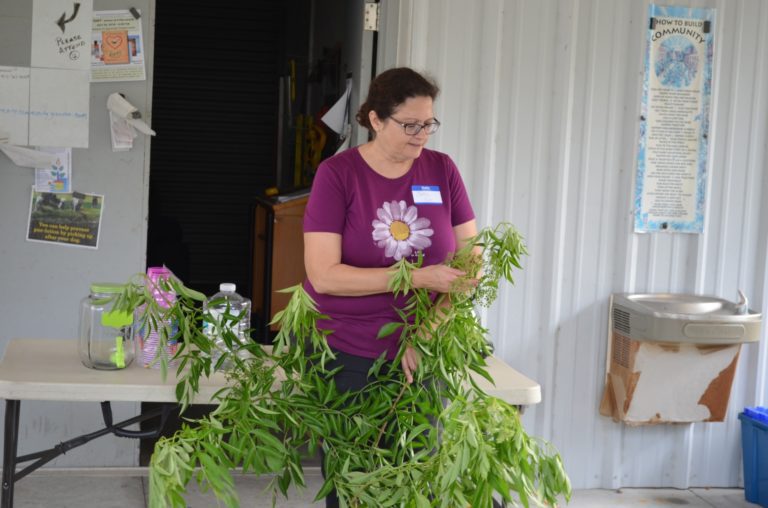
The Plant City Commons Community Garden hosted a Wild Weeding Medicines class Saturday to offer instruction on how to utilize local plant life for medicinal purposes.
Early Saturday morning, 13 nature lovers gathered at the Community Garden and watched as a clinical

herbalist turned ripe elderberries into a medicinal beverage that can be used to improve cold and flu symptoms and is high in antioxidants.
Carol Jones, clinical herbalist, guided the attendees through the Wild Weeding Medicines workshop, which aimed to teach how to use wild local plants to prepare natural “medicines.”
“What would you do if you didn’t have access to medicine and doctors?” Jones asked. “What if a hurricane came through here like it did in Puerto Rico? You have no access to antibiotics, how do you treat basic wounds?”
Florida’s tropical climate offers unique opportunities due to the extended longevity of local plant life. Because of the heat, there are local plants, many of which can be found in most back yards, that can be used for their medicinal value.
When the class began, Jones had each attendee share their name and favorite plant. Many lauded elderberry, also known as the Sambucus tree, as being their go-to natural remedy. Throughout history, it has been one of the most commonly used medicinal plants. Everyone from Native Americans, who used it for infections, to ancient Egyptians, who used it on burns, have turned to the plant in times of trouble.
If eaten raw, the berries, bark and leaves can cause stomach problems and many even label them as “poisonous.” However, that discomfort is easily remedied with a quick boil to the berries and by only using the leaves and bark for external treatments.
In the fall, it is common for the berries to be mass-produced into syrups, jams, wine or dried for a healthy and invigorating snack.

Jones walked the attendees through how to preserve different aspects of the plant via alcohol or vegetable glycerin. Taking the time to harvest the plant can save quite a lot of money. A four-ounce bag of the product from Croatia was $12.
“These are all plants that grow here in your back yard or on the side of the road,” Jones said. “Take advantage of it. Just be aware of your surroundings. If there’s a lot of dirty water flooding the area, don’t use that plant. Be observant and you’ll be surprised how much is available to you.”
Show and tell was a big aspect of the meeting as Jones brought everything from branches to preserved flowers for the class to examine. As she talked she worked, taking a large bottle of berries she had saturated with boiling water at home and straining it through a pour-over coffee filter. Another home concoction was strained through a milk bag.
Even the flowers of the plant are useful. She preserved the elderflowers she picked four weeks ago in 180 proof alcohol and then strained into a small one-ounce bottle, which she uses in small quantities for pain relief, swelling and inflammation.
Hibiscus, which is known for its colorful flowers, also has medicinal value. If used correctly it can help with upset stomachs, high blood pressure, bacterial infections and fever. The common hibiscus tea is made from a mixture of dried flowers and leaves.
Jones also preached the benefit of mixing natural remedies. She made a hibiscus, elderberry juice for those in attendance to enjoy.
Pokeweed, also known as Phytolacca Americana, has been used for improving the symptoms of arthritis, fevers, bronchitis and more. In the United States, children often use the dark berries as paint when they play outside. Its “poisonous” reputation is steeped in truth.
The plant is very toxic, but an experienced herbalist knows how to extract its medicinal qualities. Jones said when she boils the leaves she changes the water, boils them again, changes the water once more and then repeats for at least one to two more times before she’ll use the item.
The roots, if handled correctly, can also be used, but must be handled with gloves or else your skin will blister. Extremely low doses of pokeweed products, especially when mixed with other natural remedies, have been used for centuries in the United States.
Attendees asked questions, sampled the natural products and shared stories of what they were taught to do growing up. After class, Jones took those interested on a walk around the gardens where she pointed out the plants they had discussed as well as others that also have similar attributes.
